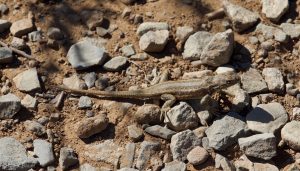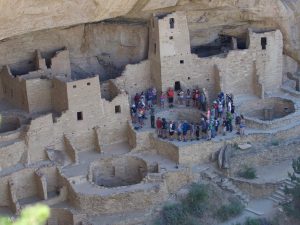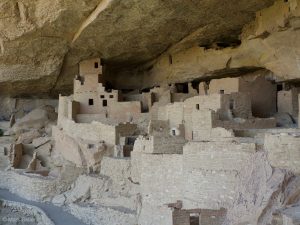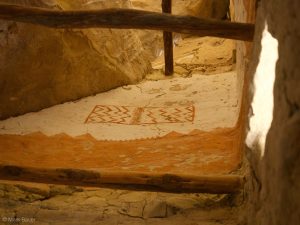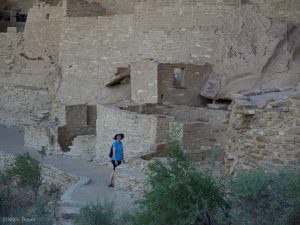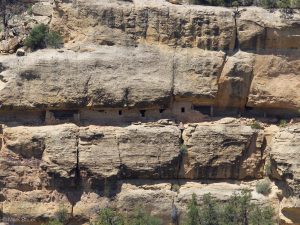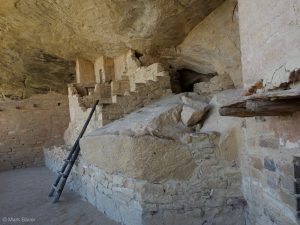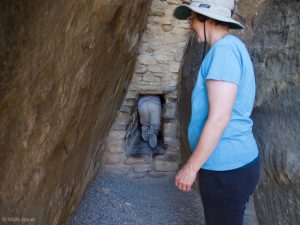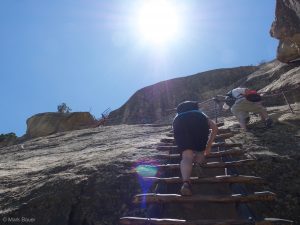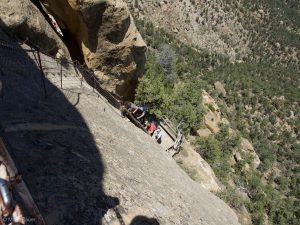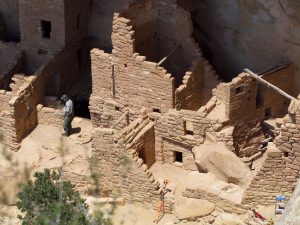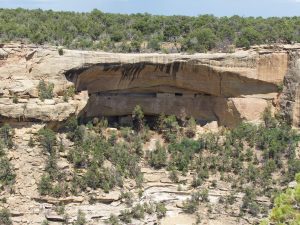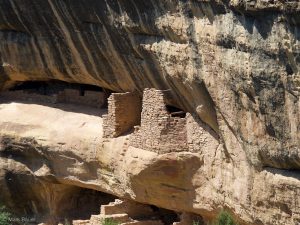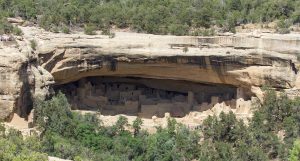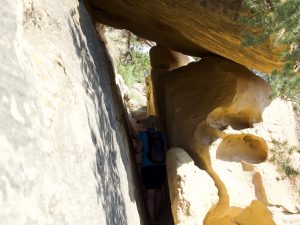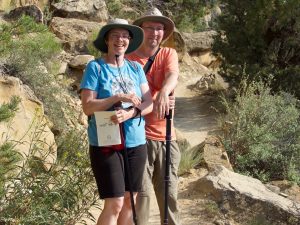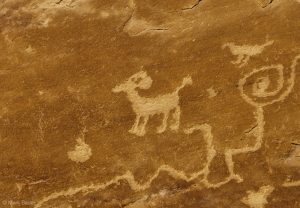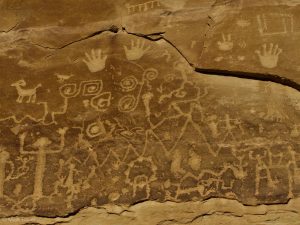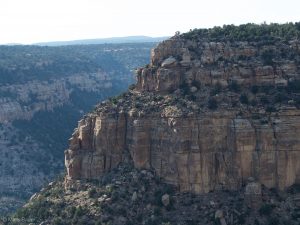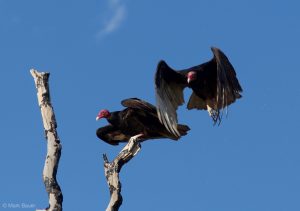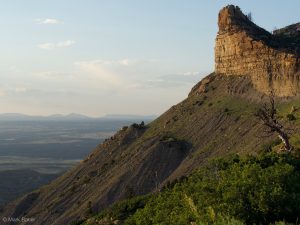Did I just say long and awesome day? We had another one, this time in Mesa Verde National Park. We had a quick breakfast at the hotel after we got up and then left around 8 am to drive to Mesa Verde, which is only about 20 minutes from Cortez. We checked at the Visitor Center and bought timed tickets for two of the tours of the cliff dwellings that are only possible with a ranger (thank goodness). Then we made our way down the long but awe-inspiring and very scenic drive (about 45 minutes) down to the Chapin Mesa area, where the Cliff Palace Loop got us to Cliff Palace. We still had time to drive the entire loop and to take a mini hike of 1.2 miles to an outlook over a canyon called Soda Canyon, then the tour began at 10:30. Cliff Palace is impressive, and apart from a steep ladder to get back out, it really wasn’t much of a climb, either. This is one of the biggest cliff dwellings, and the ranger estimated the use at 150. As we had already learned and as was stressed on both tours, the Ancestral Pueblans–now no longer called the Anazasi, because that means something like “the ancient strangers,” whereas the various tribes of pueblo Indians, the Hopi, and the Zuni consider these cliff and mesa dwellers their ancestors. We learned about building and planting techniques, about the possible religious and everyday functions of the buildings called kivas, and were reminded multiple times that we don’t know for sure why the Ancestral Pueblan people left the region (mostly for New Mexico). Drought was part of it, but other factors may have played a role, too. It’s sad and amazing to think that the 600 or so cliff dwellings that have been found (in various states of decay) were all built and abandoned within one century (between about 1200 and 1300)–so much work and then they had to pick up and leave! The buildings are amazing, even as ruins, and imagining them in complete form is, again, awe-inspiring. The tour took about an hour, and because it was morning, was mostly in the shade, which was perfect.
We had time to have our picnic lunch (also in the shade; it was getting hot!) before our second tour, at Balcony House, on the other side of the same canyon. That tour had more climbing of ladders and also a narrow tunnel we had to climb through, but I never once felt unsafe because of heights or lack of space, and the tour was again quite interesting. We heard more about the agriculture (dry farming on the “table top” of the Mesa) and about where the water in the region comes from–I had no idea that there are quite heavy rainfalls in July and August, or that water seeping through the sandstone collected in the backs of many of the alcoves where the dwellings were built into the rock. On this tour, we saw more of the wooden beams that held the ceilings/floors in place, and it was again amazing to see how much of the structures were still standing.
When we drove around the area a bit more (on the Mesa Top loop) we saw a whole bunch of additional cliff buildings, and some of them had clearly decayed or been destroyed by erosion much more than the best-preserved ones. But it was always impressive to scan the canyon sides for signs of civilization and find yet another building tucked into an overhang, sometimes “split level” style. The Mesa Top Loop was especially interesting, though, because while we could look down at more cliff dwellings, most of the loop stops were about the buildings on top of the mesa–reflecting pueblo architecture from 500 to 1200, from pit buildings with just a leather roof to more elaborate structures built on the mesa top. There were again classic kivas and typical grain storage and living rooms, and what struck me was that the kivas really looked like more stylized pit houses, so it did really seem like classic architectural evolution towards more “fine tuning.” We drove the six-mile loop in the heat of the afternoon and were very grateful that the excavated buildings were in protective buildings that also gave us shade. The last one, the Sun Temple, was a bit of a disappointment–it looked impressive from far off, but was really hard to appreciate from close up, because we couldn’t go in or see into it, because the walls were too high. It was apparently basically abandoned right after it was finished, in the 13th century, as the Ancestral Pueblans left.
We were good and hot by the time we were done with the Mesa Top loop and used the museum located at this site to cool off. It was clearly an older part of the National Park, with too many artifacts and not enough location information, so that we had to just assume that some of the awesome pottery we saw was really found in this region and that it was old. There were even some dioramas, and the whole exhibit had a sort of 60s feel. But it was a chance to cool off. The area also has a small restaurant and we decided to just have a quick bite–even though it was only 4:45, we were pretty sure we were not going to last until after the hike we had planned on. It was almost empty (very pleasant–not at all like the zoo in Yellowstone or Yosemite) and not outrageously pricy either for a veggie wrap and a hamburger. Then we found our way onto the Petroglyph trail, which is a 2.4 mile round trip trail that starts near Spruce House, the cliff dwelling that is currently closed because of concerns that part of the alcove above will collapse. The trail was fabulous–there was a natural tunnel to scramble through, great views of the canyon and several of the cliff dwellings, and (although this was not advertised in the trail guide) we actually walked right through a cliff dwelling that had decayed fairly far. We hiked the trail with three sisters from Iowa who had almost decided to turn back when we came along and seemed to know what we were doing, so we all kept each other company and chatted while going along. The petroglyphs are about 1.2 miles out, just before the trail loops back to the museum, and they were really quite impressive–even as the modern interpretation of several of the the glyphs is probably a bit iffy. We even saw some wildlife beyond the little lizards we’d been seeing all day–some turkey vultures very close up, and some deer–and the hike was a great success. We were tired when we started the hour-long drive back, but we still got out several more times on the way to gawk at the scenery–at several points, we could see far, far into the distance on both the West and East sides, and at the Knife Edge outlook, underneath a huge outcropping, we could still see the last traces of an older road from the early 20th century (for the first automobile tourists). As we drove back into Cortez, we could see the sun set in a gorgeous orange sky; treated ourselves to a dessert at the Denny’s across the street from the motel (which we actually got for free because they had a horrible time getting around to serving us or even bringing us our water), and wrapped up the day with photo viewing and blogging!
